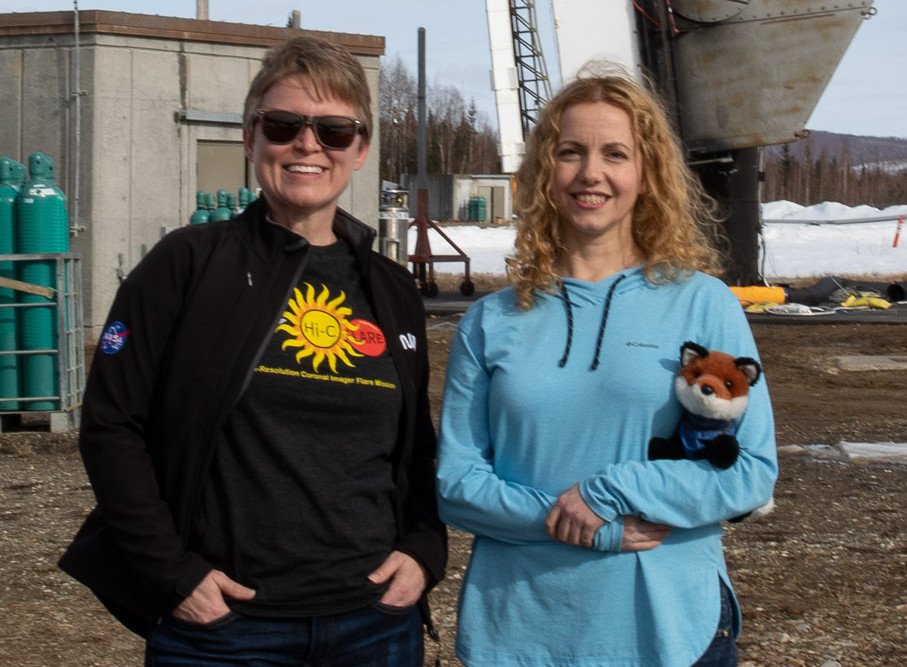Glesener part of NASA's first solar flare observation campaign

.
Professor Lindsay Glesener, of the School of Physics and Astronomy is part of a research team launching a sounding rocket to study solar flares. The rocket, named Focusing Optics X-ray Solar Imager (FOXSI-4), is equipped with an X-ray telescope that will gather precise measurements of this solar phenomenon.
A solar flare is a bright burst of light from the sun that can be seen across the entire electromagnetic spectrum. Solar flares and their accompanying plasma ejections can cause geomagnetic storms that can have impacts on power grids and communication satellites on Earth. Understanding how these solar flares happen can help us better react in real time to avoid disruptions.
In NASA’s first solar flare observation campaign, the researchers will be studying the earliest signature of solar flares. A major challenge is that researchers will have only five minutes to collect the data after the FOXSI-4 rocket is launched from the Poker Flat Research Range in Alaska. This kind of effort has never been tried before during a solar flare.
Sounding rockets typically launch from the White Sands Missile Range in New Mexico, but the solar flare campaign requires a more flexible launch schedule than that missile range can allow. In Alaska, FOXSI-4 will be ready on the launch pad for two weeks, waiting for the perfect opportunity to capture a solar flare.
Once the sounding rocket is launched, they will be looking at low energy X-rays from National Oceanic and Atmospheric Association (NOAA)’s GOES Satellite. They will be able to study live solar flare data at the launch facility to pick the perfect moment to launch their sounding rocket.
“Hard X-rays are closely linked to the energy release that powers solar flares. There are a lot of questions that go along with this. We know that the energy is stored in the magnetic field of the Sun’s corona prior to the event, but we don’t know how the event is kicked off or the details of what happens to the energy after it is released,” said Lindsay Glesener, a University of Minnesota associate professor in the College of Science and Engineering’s School of Physics and Astronomy.
The energy release happens very early on in a solar flare, so researchers will need to observe the X-rays as close to the start of the solar flare as possible.
The goal of this project is to collect meaningful data in that five-minute time period to expand this research to build solar dedicated spacecraft instruments that would observe the sun for longer periods of time.
“We are conducting this research now because we are coming into a period of relatively high solar activity, the solar maximum, which means there are a large number of solar flares happening on the sun,” Glesener said.
FOXSI became the first solar-dedicated instrument to observe hard X-rays with focusing optics in 2012. The three previous successful FOXSI sounding rocket launches were aimed at studying the sun when there was no activity happening. FOXSI-4 is equipped with new technology including high-resolution hard X-ray mirrors to better isolate the many regions of magnetic energy release during flares.
In addition to Glesener, researcher Thanasi Pantazides, postdoctoral student Kris Cooper, and Ph.D. students Yixian Zhang and Marianne Peterson in the School of Physics and Astronomy at the University of Minnesota are involved in the launch.
This project is a collaboration between the University of Minnesota, the Space Sciences Laboratory at University of California-Berkeley, NASA Goddard Space Flight Center, NASA Marshall Space Flight Center, University of Tokyo IPMU, Nagoya University, Fachhochschule Nordwestschweiz (FHNW), National Astronomical Observatory of Japan (NAOJ), the Japanese Aerospace Exploration Agency, and Johns Hopkins University Applied Physical Laboratory.